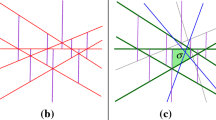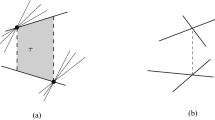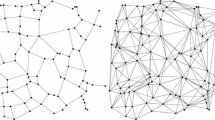Abstract
This paper presents several algorithms for projecting points so as to give the most uniform distribution. Givenn points in the plane and an integerb, the problem is to find an optimal angleθ ofb equally spaced parallel lines such that points are distributed most uniformly over buckets (regions bounded by two consecutive lines). An algorithm is known only in thetight case in which the two extreme lines are the supporting lines of the point set. The algorithm requiresO(bn2 logn) time and On2+bn) space to find an optimal solution. In this paper we improve the algorithm both in time and space, based on duality transformation. Two linear-space algorithms are presented. One runs in On2+K log n+bn) time, whereK is the number of intersections in the transformed plane.K is shown to beO(@#@ n2+bn@#@) based on a new counting scheme. The other algorithm is advantageous ifb < √n. It performs a simplex range search in each slab to enumerate all the lines that intersectbucket lines, and runs in O(b0.610n1.695+K logn) time. It is also shown that the problem can be solved in polynomial time even in therelaxed case. Its one-dimensional analogue is especially related to the design of an optimal hash function for a static set of keys.
Similar content being viewed by others
References
A. V. Aho, J. E. Hopcroft, and J. D. Ullman: Problem 2.12,The Design and Analysis of Computer Algorithms, Addison-Wesley, Reading, MA, 1974.
T. Asano, L. J. Guibas, and T. Tokuyama: Walking on an Arrangement Topologically,Proc. 7th ACM Symposium on Computational Geometry, pp. 297–306, 1991.
J. L. Bentley and T. Ottman: Algorithms for Reporting and Counting Geometric Intersections,IEEE Trans. Comput., vol. 28, pp. 643–647, Sept. 1979.
B. Chazelle, L. J. Guibas, and D. T. Lee: The Power of Geometric Duality,Proc. 24th Symposium on Foundations of Computer Science, pp. 217–225, 1983.
D. Comer and M. J. O'Donnell: Geometric Problems with Applications to Hashing,SIAM J. Comput., vol. 11, no. 2, pp. 217–26, 1982.
H. Edelsbrunner:Algorithms in Combinatorial Geometry, EATCS Monographs in Theoretical Computer Science, vol. 10, Springer-Verlag, Berlin, 1987.
H. Edelsbrunner and L. J. Guibas: Topologically Sweeping an Arrangement, Research Report 9, Digital Systems Research Center, 1986.
H. Edelsbrunner and E. Welzl: Half Planar Range Search in Linear Space andO(n 0.695) Query Time,Inform. Process. Lett., vol. 23, pp. 289–193, 1986.
K. Mehlhorn:Data Structures and Algorithms, 1: Sorting and Searching, EATCS Monographs on Theoretical Computer Science, Springer-Verlag, Berlin, 1984.
F. P. Preparata and M. I. Shamos:Computational Geometry—An Introduction, second edition, Springer-Verlag, New York, 1985.
Author information
Authors and Affiliations
Additional information
Communicated by Takao, Asano
This work was supported in part by a Grant in Aid for Scientific Research of the Ministry of Education, Science, and Cultures of Japan.
Rights and permissions
About this article
Cite this article
Asano, T., Tokuyama, T. Algorithms for projecting points to give the most uniform distribution with applications to hashing. Algorithmica 9, 572–590 (1993). https://doi.org/10.1007/BF01190156
Received:
Revised:
Issue Date:
DOI: https://doi.org/10.1007/BF01190156




